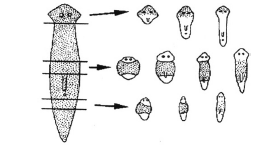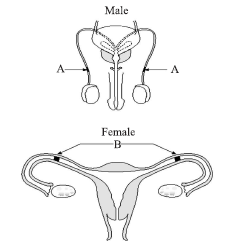How do the Organisms Reproduce Class 10 MCQ is one of the best strategies to prepare for the CBSE Class 10 Board exam. If you want to complete a grasp concept or work on one’s score, there is no method except constant practice. Students can improve their speed and accuracy by doing more How do the Organisms Reproduce class 10, which will help them all through their board test.
How do the Organisms Reproduce Class 10 MCQ Questions with Answer
Class 10 Science MCQ with answers are given here to chapter 8 How do the Organisms Reproduce. These MCQs are based on the latest CBSE board syllabus and relate to the latest Class 10 Science syllabus. By Solving these Class 10 MCQs, you will be able to analyze all of the concepts quickly in the chapter and get ready for the Class 10 Annual exam.
Learn How do the Organisms Reproduce Class 10 MCQ with answers pdf free download according to the latest CBSE and NCERT syllabus. Students should prepare for the examination by solving CBSE Class 10 How do the Organisms Reproduce MCQ with answers given below.
Question 1. Assertion: Ovary releases one egg every month.
Reason: The lining of uterus is always thick and spongy.
(a) Both A and R are true and R is the correct explanation of A.
(b) Both A and R are true but R is not the correct explanation of A.
(c) A is true but R is false.
(d) A is false but R is true.
(e) Both A and R are false.
Answer
C
Question 2. Along the path of the vas-deferens the secretions of which gland provide nutrition to the sperms?
(a) Prostate glands
(b) Seminal vesicles
(c) Scrotum
(d) Urinary bladder
Answer
B
Question 3. In a potato, vegetative propagation takes place by:
(a) root
(b) leaf
(c) stem tuber
(d) grafting
Answer
C
Question 4. Anemophily is the pollination by –
(a) Birds
(b) Rain
(c) insects
(d) Wind
Answer
D
Question 5. When the foetus is growing inside the uterus it needs nutrients. Which part provides these nutrients?
(a) Placenta
(b) Amniotic sac
(c) Oviduct
(d) Uterus
Answer
A
Question 6. Assertion: In human beings, the female. play a major role in determining the sex of the offspring.
Reason: Women have two X chromosomes.
(a) Both A and R are true and R is the correct explanation of A.
(b) Both A and R are true but R is not the correct explanation of A.
(c) A is true but R is false.
(d) A is false but R is true.
(e) Both A and R are false.
Answer
D
Question 7. Which of this is seminal fluid?
(a) Prostate gland
(b) Cowper’s gland
(c) Seminal vesicle
(d) all of these
Answer
C
Question 8. The fertilisation of human egg by the sperm takes place in
(a) vagina
(b) uterus
(c) ovary
(d) oviduct
Answer
D
Question 9. When a sperm is deposited into the vagina which route does it travel ?
(a) Vagina → Oviduct → Uterus → Cervix
(b) Vagina → Ovary → Uterus → Oviduct
(c) Vagina → Cervix → Uterus → Oviduct
(d) Vagina → Uterus → Cervix → Oviduct
Answer
C
Question 10. Many unicellular organisms reproduce by the process of
(a) fission
(b) ovulation
(c) regeneration
(d) non-disjunction
Answer
A
Question 11. Anemophily is the pollination by:
(a) Birds
(b) Rain
(c) insects
(d) Wind
Answer
D
Question 12. Which of the following is a primary sex organ in a mammal?
(a) Ovary
(b) Vagina
(c) Uterus
(d) Mammary glands
Answer
A
Question 13. Which part of the flower forms the fruit?
(a) Whole flower
(b) Only stamens and carpel
(c) Only ovary
(d) Only carpel
Answer
C
Question 14. A pair of duct arising from testis, which carry sperms are
(a) fallopian tube
(b) vas deferens
(c) oviduct
(d) urethra
Answer
B
Question 15. The period during adolescence when the reproductive tissues begin to mature is called
(a) ovyfetion
(b) puberty
(c) germination
(d) propagation
Answer
B
Question 16. When an organism breaks into a number of parts and each part develop into an individual, it is called:
(a) Budding
(b) Binary fission
(c) Regeneration
(d) Spore formation
Answer
C
Question 17. Which is the most common method of reproduction in majority of fungi and bacteria?
(a) Budding
(b) Spore formation
(c) Binary fission
(d) Multiple fission
Answer
B
Question 18. The process of release of eggs from the ovary is called
(a) menstruation
(b) reproduction
(c) insemination
(d) ovulation
Answer
D
Question 19. In Rhizopus, tubular thread like structures bearing sporangia at their tips are called
(a) filaments
(b) hyphae
(c) rhizoids
(d) roots
Answer
B
Question 20. Assertion: In male reproductive system, transport of sperm takes place in a fluid which also provide nutrition. Reason: Protective glands and seminal vesicles secret in the vas deferens.
(a) Both A and R are true and R is the correct explanation of A.
(b) Both A and R are true but R is not the correct explanation of A.
(c) A is true but R is false.
(d) A is false but R is true.
(e) Both A and R are false.
Answer
A
Question 21. In man, fertilization of ovum takes place in
(a) Vagina
(b) ovary
(c) uterus
(d) Fallopian tubes
Answer
D
Question 22: Menstrual cycle is generally of
(a) 21 days
(b) 28 days
(c) 38 days
(d) 40 days
Answer
B
Question 23: Plants of desired qualities are produced by:
(a) Cutting
(b) Grafting
(c) Layering
(d) Any one of (a), (b),(c)
Answer
B
Question 24. At the time of entering into ovule, pollen tube has
(a) three male nuclei
(b) two male nuclei
(c) one gamete nucleus
(d) four male gametes
Answer
B
Question 25. During favourable conditions, Amoeba reproduces by
(a) multiple fission
(b) binary fission
(c) budding
(d) fragmentation
Answer
B
Whoever needs to take the CBSE Class 10 Board Exam should look at this MCQ. To the Students who will show up in CBSE Class 10 Science Board Exams, It is suggested to practice more and more questions. Aside from the sample paper you more likely had solved. These How do the Organisms Reproduce Class 10 MCQ are ready by the subject specialists themselves.
Question 26: Example of external fertilization is
(a) fish and frog
(b) frog and monkey
(c) dog and goat
(d) goat and fish
Answer
A
Question 27: Budding and fission are processes used by
(a) diocious species.
(b) hermaphroditic organisms.
(c) organisms requiring new gene combinations for each generation.
(d) asexually reproducing species.
Answer
D
Question 28: Tunica albuginea is the covering around
(a) ovary
(b) testes
(c) kidney
(d) heart
Answer
B
Question 29: The vegetative reproduction in sweet potato is done by –
(a) stem
(b) leaf
(c) root
(d) flower
Answer
C
Question 30 : In mammals, the testes lie in scrotal sacs due to
(a) presence of urinary bladder.
(b) presence of rectum.
(c) long vas-deferens.
(d) requirement of low temperature for spermatogenesis.
Answer
D
Question 31: The correct sequence of reproductive stages seen in flowering plants is
(a) gametes, zygote, embryo, seedling
(b) zygote, gametes, embryo, seedling
(c) seedling, embryo, zygote, gametes
(d) gametes, embryo, zygote, seedling
Answer
A
Question 32: Gemmule formation in sponges is helpful in:
(a) Parthenogenesis
(b) Sexual reproduction
(c) Only dissemination
(d) Asexual reproduction
Answer
D
Question 33: Ovulation in mammals is caused by:
(a) FSH and TSH
(b) FSH and LH
(c) FSH and LTH
(d) LTH and LH
Answer
B
Question 34: The figure shown above illustrates which method of vegetative propagation?
(a) Bud formation
(b) Grafting
(c) Layering
(d) Spore formation
Answer
B
Question 35: The following figure represents :

(a) Budding in Hydra
(b) Budding in Planaria
(c) Regeneration in Planaria
(d) Regeneration in Hydra
Answer
C
Question 36: In figure, the parts A, B and C are sequentially:
(a) cotyledon, plumule and radicle
(b) plumule, radicle and cotyledon
(c) plumule, cotyledon and radicle
(d) radicle, cotyledon and plumule
Answer
C
Question 37: In the figure of budding in Yeast, structures a, b, c and d should be labelled respectively as

(a) Nucleus of bud, bud, Yeast, nucleus
(b) Dividing nucleus of bud, bud, Yeast, nucleus
(c) Nucleus of bud, bud, Yeast, dividing nucleus of yeast
(d) Dividing nucleus of Yeast, Yeast, bud, nucleus of bud.
Answer
A
Question 38: Vegetative propagation is possible by
(a) Root
(b) Stem
(c) Leaves
(d) All of these
Answer
D
Question 39: Ovaries produce
(a) oestrogen and progesterone
(b) oestrogen only
(c) progesterone only
(d) testosterone
Answer
A
Question 40: The diagrams below represent the reproductive systems in the human male and female.

The blockages shown at A and B would most likely interfere with the ability to
(a) transport gametes
(b) produce mature gametes
(c) eliminate waste products through the urethra
(d) express secondary sex characteristics
Answer
A
Question 41: Site of fertilization in mammals is
(a) ovary
(b) uterus
(c) vagina
(d) fallopian tube
Answer
D
Question 42: Fertilization does not occur in which part?
(a) fallopian tube
(b) ampulla
(c) oviduct
(d) vagina
Answer
D
Question 43: Progesterone is secreted by
(a) corpus luteum
(b) thyroid
(c) thymus
(d) testes
Answer
A
Question 44: Oral-contraceptives prevent the
(a) fertilization
(b) ovulation
(c) implantation
(d) entrance of sperms in vagina
Answer
B
Question 45: The general method of asexual reproduction, in yeast fungus is –
(a) by spores
(b) by budding
(c) binary fission
(d) gemma
Answer
B
Question 46: Seminiferous tubules are composed of
(a) Spermatogonia
(b) Glandular epithelium
(c) Sensory epithelium
(d) Germinal epithelium
Answer
D
Question 47: Cowper’s glands are found in
(a) male mammals
(b) female mammals
(c) male amphibians
(d) female amphibians
Answer
A
You can easily get good marks If you study with the help of Class 10 How do the Organisms Reproduce MCQ. We trust that information provided is useful for you. NCERT MCQ Questions for Class 10 How do the Organisms Reproduce PDF Free Download would without a doubt create positive results.
We hope the information shared above in regards to MCQ on How do the Organisms Reproduce Class 10 with Answers has been helpful to you. if you have any questions regarding CBSE Class 10 Science Solutions MCQs Pdf, write a comment below and we will get back to you as soon as possible.
Frequently Asked Question (FAQs)
How many MCQ questions are there in Class 10 Chapter 8 Science?
In Class 10 Chapter 8 Science, we have provided 47 Important MCQ Questions, But in the future, we will add more MCQs so that you can get good marks in the Class 10 exam.
Can we score good marks in Class 10 Science with the help of How do the Organisms Reproduce MCQ Questions?
Yes, MCQ Question is one of the best strategies to make your preparation better for the CBSE Board Exam. It also helps to know the student’s basic understanding of each chapter. So, You can score good marks in the Class 10 Science exam.